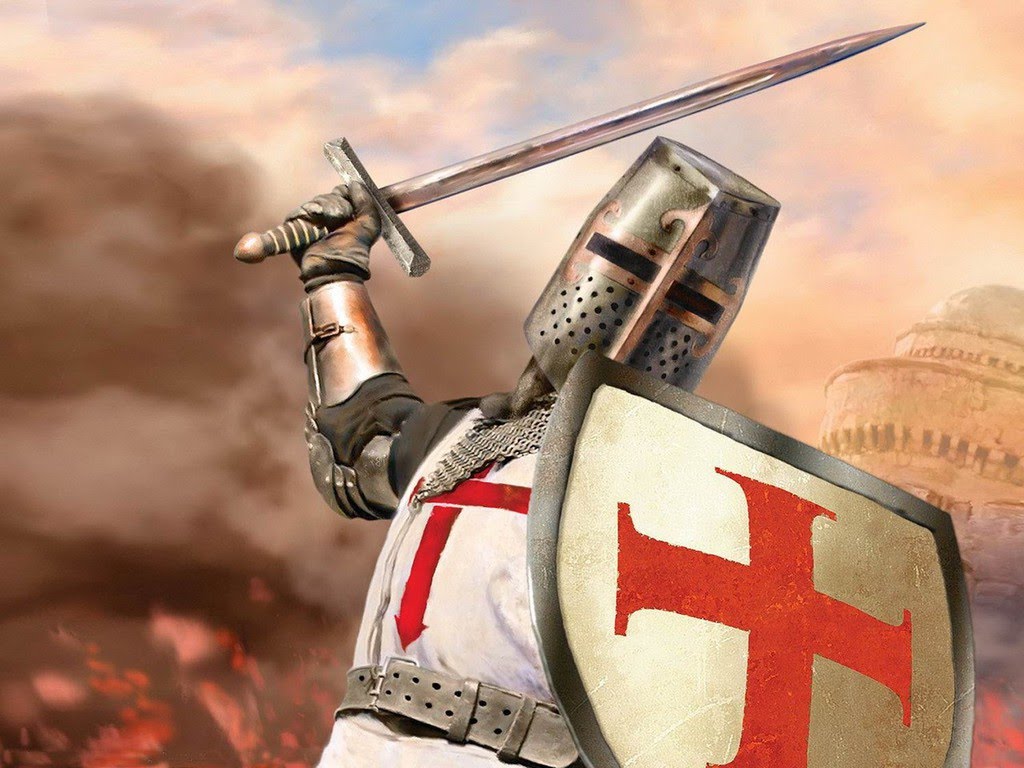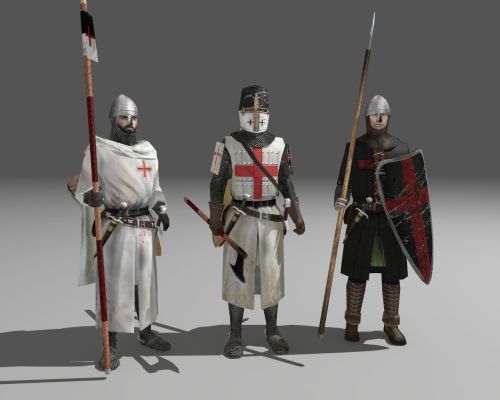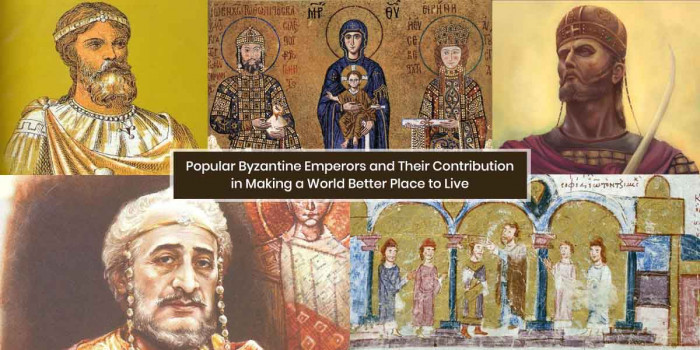Knights Templar: A Catholic Military Order of Devout Christians from the Medieval Era
The Knights Templar became a popular organization throughout Christendom and grew in power during medieval times. Learn more about them here.

The Knights Templar was a large organization of devout Christians during the medieval era who carried out a mission to protect European travelers visiting sites in the land while also performing military operations.
The Templars became a charity throughout Christians and grew in membership and power. Knights Templar, or known as the poor fellow-soldiers of the Christ and the temple of Solomon, was a catholic military order founded in 1119. They gained attention in 1139 by the papal bull Omne datum optimum.
Who were the Knights Templar?
On Christmas day1119, King of Jerusalem Baldwin II persuaded a group of French knights led by Hugh de Payne to save their souls by protecting pilgrims traveling the Holy Land. Many of them were killed as they crossed through Muslim-controlled territories during their journey. With the support of Baldwin II, they set the headquarters on that city’s sacred Temple Mount.
Initially, they faced criticism from religious leaders. In 1129 the group received the Catholic Church endorsement and support from Bernard of Clairvaux, a prominent French abbot. In 1139, Pope II issued a Papal Bull and allowed the Knights Templar special rights. The Templars were exempted from paying taxes.
The revolutionary order of knights lived as monks, but they lived with a difference. They would take arms to protect the civilians using the roads of the conquered Kingdom of Jerusalem. Over the 900 years, the warrior monks became associated with the Holy Grail. The crusades ended in 1291 after the capital of Acre fell and the templars found themselves redundant. But the French King was capitalized on their vulnerability, and the Templars were arrested in France in 1307.
Rise of This Catholic Military Order
In 1119, the French knight Hugues de Payens approached King Baldwin II and proposed creating a monastic order for the pilgrim protection. They agreed to the request at the Council of Nablus in January 1120 and granted the templars a headquarter in the royal palace on the Mount in the captured Al-Aqsa Mosque.
The Crusaders, therefore, referred to the AI-Aqsa Mosque as Solomon’s temple. The status of templates didn’t last long. They had an advocate in Saint Bernard of Clairvaux. The French abbot was responsible for the founding of the Cistercian Order of monks and one of the founding knights.
The Decline
During the 12th century, the tide began to turn in the Crusades. The Islamic world became more united under leaders. The Knights Templar were at odds with other Christian military orders - the Teutonic Knights and the Knights Hospitaller. After the Templars were involved in unsuccessful campaigns, Jerusalem was recaptured by Muslim forces under Saladin in 1187.
The Templars were forced to move to their headquarters, which they held for the next century. Later, their headquarters were moved to Limassol (the city on the southern coast of Cyprus). In 1300, there was an attempt to engage in the military efforts with the Mongols.
In 1303, the Templars lost their island to the Egyptian Mamluk Sultanate in the Siege of Arwad. The Templars still managed businesses, and Europeans had daily contact with the Templar network.
Arrests, Charges, and Dissolution

In 1305, Pope Clement V sent letters to Templar Grandmaster and Jacque de Moley (23rd and the last master of the Knights Templar) and Fulk de Villaret to discuss the merging of two orders. De Moley arrived in 1307, but de Vilaret came late after several months. They discussed the criminal charges that were made earlier by an ousted Templar.
On 13th October 1307, King Philip ordered de Moley and other French Templars to be arrested. The claims were made that during Templar admissions ceremonies, the recruits were forced to spit on the Cross and engage in indecent kissing. The allegations were politicized without evidence.
The Templars were charged with other offenses like fraud and secrecy. The prisoners were forced to confess about spatting on the cross. Pope Clement then issued the papal bull on 22nd November, which ordered the Christian Monarch in Europe to arrest Templars and seize their assets. He called for hearings to determine the Templar’s innocence.
Some of them had the experience to defend themselves, but in 1310, Phillippe de Marigny led the investigation and blocked this attempt using the forced confessions to have several of the Templars burned at stake in Paris. Pop Clement agreed to disband the order, citing the public scandal generated by the confessions.
Later, the remaining Templars around Europe were arrested or tried under the Papal investigation or pensioned off and lived their days peacefully.
Chinon Parchment
In 2001, a document referred to as Chinon Parchment was discovered in the Vatican Secret of Archives after being wrongly filled in 1628. The document was the Templars’ trial and showed that Clement absolved the Templars of all heresies in 1308 before disbanding the order in 1312.
Organization
The Templar was organized as a monkhood similar to Bernard’s Cistercian Order, which was considered the effective international organization in Europe. Each country with a major Templar presence had a Master of the Order for the Templars in that region. The visitors general had the power to remove Knights and to suspend the Master of the province concerned.
Ranks Within Order

There was a division of ranks of the Templar. They were ranked as the noble knights, the non-noble sergeants, and the chaplains.
They were the branch of the order and wore white mantles to symbolize their purity and chastity. They were known for having three or four houses and two squires. They have bright skills and trades from blacksmiths and builders. In the Crusader States, they fought with knights with a single horse.
Legacy and Modern Organizations
With the financial resources, the Knights Templar funded several building projects around Europe and the Holy Land. A few of these structures are still standing. The Knights Templar were dismantled in the Rolls of the Catholic Church in 1309. The story of the persecution of the secretive and medieval Templars has drawn other groups to use connections for the mystery.
Modern Popular Culture
The modern Knights Templar are associated with legends. Masonic writers added their speculations in the 18th century. At the beginning of the 1960s, the publications surrounded the Templar Mount's early occupation in Jerusalem about the temple relics found there, such as the Holy Grail quest.
Popular Knights Templar Sites
1. Al-Aqsa Mosque, Jerusalem

Situated in the old city of Jerusalem, AI-Aqsa Mosque is the third holiest site in Islam. This mosque was built on top of the Temple Mount. People, especially Muslims, believe that Muhammad was carried from the Great Mosque of Mecca to Al-Aqsa during the night journey.
The building was a small prayer house constructed by Umar and was rebuilt by Abd al-Malik and completed by his son al-Wajid. Unfortunately, the mosque was destroyed by an earthquake in 746 and rebuilt by the Abbasid caliph al-Mansur in 754. Beneath the dome, you can find a prayer hall located in the southern part of the mosque. It is one of the few domes to be built in front of the mihrab during the Abbasid periods.
2. Tell es-Safi

It was an Arab Palestinian village, situated on the southern banks of Wadi, Ajjur, and northwest of Hebron. Archaeological excavations showed that the site was inhabited since the 5th millennium BC and appeared on the Madaba Map as Saphitha.
Today, the place is known as Tel Tzafit. It is a popular Israel national perk and incorporates archaeological remains, which have been identified as the Philistine city of Gath.
3. Kolossi Castle

Kolossi Castle is a crusader on the south-west of the Kolossi village on the island of Cyprus. It holds importance in the Middle Ages and includes large facilities for the production of sugar from the local sugarcane.
The original castle was built in 1210 by the Frankish military when the land of Kolossi was given by King Hugh I to the Knights of the Order of St John of Jerusalem.
The castle today includes a single three-story keep with a rectangular enclosure, which can be measured 30 by 40 meters. In literature, Kolossi castle appears in several works of fiction, including La militia de Dios. It also appeared in Snow Wastedby the Cypriot author Mathew Malekos and other novels.
4. La Rochelle

La Rochelle is a city located on the central west coast of France and a seaport on the Bay of Biscay. The city traces its origin back to the Gallo-Roman period. The opening of the English market following the second marriage of Eleanor of Aquitaine 1152 and the Knights Templar’s presence made this town the largest port on the Atlantic.
La Rochelle was the templar’s largest base on the Atlantic Ocean. A popular thread of conspiracy originated with Holy Blood has it that the templars used a fleet of 18 ships, which brought Jacques de Molay from Cyprus to La Rochelle to escape arrest in France.
Do you know more about the Knights Templar? If yes, then share the facts about them.
Popular Posts
Top 10 Sharpest & Deadliest Swords In History
In classic mythological movies, books and television, we’ve seen those audacious sword-wielding heroes smiting the enemi...
Augustus Perez
List of Water Deities from Different Mythologies
Water deities are the gods and goddesses who had the powers to control the elements of water and ruled over all the fresh and saltwater of the earth. Here’s a list of water deities from different mythologies.
Rishika Gupta
Winged Lion: The Terrifying Mythical Creature In Different Mythologies
A mythological creature, a winged lion dates back to ancient times. This flying lion-like creature has origins in Heraldry, Christianity, Mesopotamian, and Greek mythologies.
Ethan Stephans








